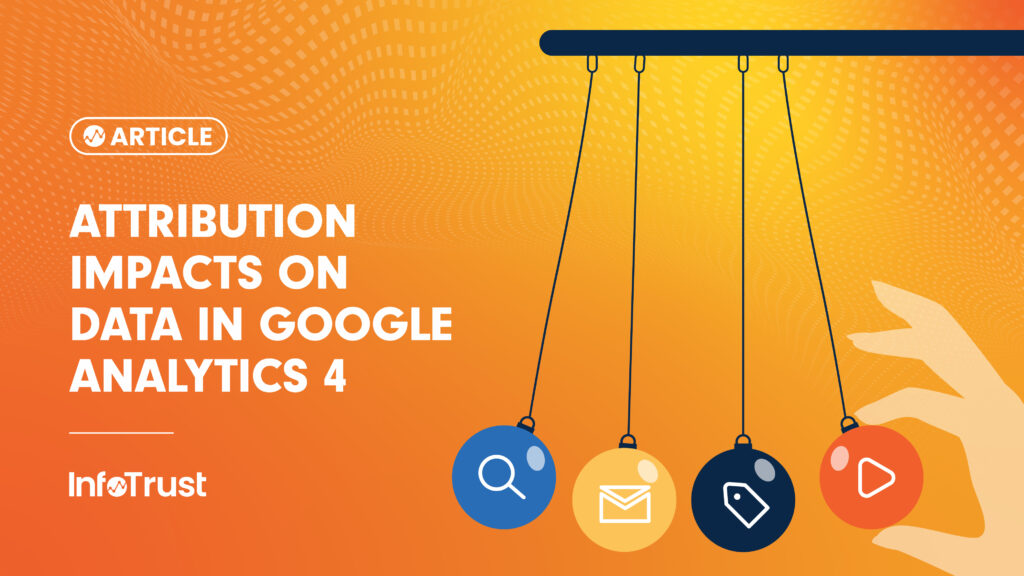In Universal Analytics (sometimes known as GA360 or GA3), the fundamental marketing traffic source dimensions include Channel Grouping, Source, Medium, and Campaign. This structure remains consistent in Google Analytics 4 (GA4); however, each dimension has three types. Each dimension has a distinct scope, and when combined with metrics, they offer varying insights:
- First User Source: Represents the initial source associated with a user. For instance, if a user first arrived at your site via a Facebook link, their First User Source will always be Facebook. This dimension is the default type in the Acquisition -> User Acquisition report.
- Session Source: Indicates the source that triggered the session. In an example user journey with Customer X, the Session Source would be Google because the session started with a click on a Google Search ad. Session dimensions are default in the Acquisition -> Traffic Acquisition reports.
- Source: Refers to a source that contributed at least partially to a conversion according to the default attribution model. Source is the default dimension, specifically in the Advertising -> Advertising Snapshot report.
Each dimension yields distinct results based on the context and metrics applied.
How Do Attribution Settings in GA4 Impact Data?
GA4 introduces Data-Driven Attribution (DDA), a promising novel feature. To ease concerns, it’s important to clarify that Google will uphold its existing attribution model choices. Some built-in reports in GA4 align with a model akin to the last-click attribution methodology.
Users can also select between last-click and data-driven attribution models available in a drop-down menu within some built-in reports.

Explore reports will use the attribution model selected in property settings. However, certain user- and session-scoped dimensions, such as Session Source or First-User Medium, are unaffected by the default attribution model.
Adjusting the reporting attribution model impacts all principal event reports and analyses utilizing event-scoped traffic dimensions, such as Source, Medium, Campaign, and Default Channel Group. Within the Explore section, a comprehensive list of dimensions compatible with attribution is available for review. It’s important to note that traffic dimensions scoped at the user and session level, like Session Source or First User Medium, remain unchanged when altering the reporting attribution model.

Opting for data-driven as the primary attribution model designates it as the default attribution method in nearly all reports within the UI. However, users can swap between data-driven and last-click in specific reports.

Data-driven attribution is an innovative approach that assesses users’ source/medium/campaign interactions across their journeys to ascertain pivotal factors influencing conversions. This model employs a weighting mechanism to assign credit, giving more weight to significant combinations that drive conversions and less weight to less impactful interactions.
Consider a hypothetical scenario involving Customer A, where various interactions, such as a paid search ad click, an organic search ad click, and an affiliate click, lead to a conversion event.
[Session 1]
- At 8:00 a.m., they search “makeup“ on Google. They see your ad at the top of the search, click on the ad, and land on your site.
- At 8:04 a.m., after browsing for a few minutes, they return to the search and explore what other brands have to offer.
[Session 2]
- At 8:45 a.m., after looking through other brands‘ products, they decide on your offerings. They go back to Google, search for your company name, and click on your organic search listing to return to your site.
- At 8:46 am, after browsing, they find a ready-to-ship product and add it to their cart.
- At 8:48 a.m., they hoped to find a coupon code for your site. They searched Google and found one on an affiliate site.
- At 8:52 am, they complete their purchase, and the new product is theirs.
This journey to conversion included:
- Paid search ad click
- Organic search ad click
- Affiliate
- Conversion
In analyzing the credit allocation for the “affiliate” touchpoint in this conversion journey, Google’s machine learning algorithms evaluate similar conversion paths to determine the influence of the affiliate click on the conversion process. These evaluations are based on conversion rates (now known as “key event” rates in GA4), assessing paths like paid search ad click -> organic search ad click and paid search ad click -> organic search ad click -> affiliate click.
This approach emphasizes the importance of touchpoints in the conversion journey and showcases how revenue attribution differs between Universal Analytics and GA4. In GA4, revenue attribution varies based on the attribution model selected, with different percentages attributed to paid search, organic search, and affiliate based on their significance as determined by the DDA algorithm. When looking at first-user channel grouping, 100 percent of the revenue would be attributed to paid search. When looking at session channel grouping, 100 percent of the revenue would be attributed to organic search. However, when looking at channel grouping, the revenue would be divided between paid search, organic search, and affiliate, depending on the DDA algorithm.
In UA, 100 percent of the revenue would be attributed to the affiliate from which the coupon code was taken, as this was the last non-direct click before conversion.
| (Last Touch) | (First Touch) | (Session Source) | (Default Attribution Settings - in this scenario, this is DDA) | |
|---|---|---|---|---|
| Universal Analytics Revenue Attribution | GA4 Revenue Attribution (First User Channel Grouping) | GA4 Revenue Attribution (Session Channel Grouping) | GA4 Revenue Attribution (Channel Grouping) | |
| Paid Search | 100% | Ex: 50% | ||
| Organic Search | 100% | Ex: 20% | ||
| Affiliate | 100% | Ex: 30% |
Documentation on Session and User-Scoped Dimensions demonstrates the differences you will see in event, user, and session scope dimensions using example data sets. We recommend reviewing this document.
What to Use When Comparing Attribution UA to GA4
When comparing attribution reports between UA and GA4, it’s essential to focus on specific marketing traffic source dimensions that align more closely with UA’s methodology despite the inherent differences in attribution models and data handling between the two platforms. In GA4, to facilitate a more direct comparison, pay close attention to dimensions such as “First User Source”, and “Session Source,” as these dimensions offer insights into the initial and subsequent traffic sources driving user behavior and conversions. Additionally, leveraging the “Conversion Event” (being renamed by Google to “key event”) dimension in GA4 allows for an analysis that mirrors UA’s focus on conversion or transaction-specific metrics. To align with UA’s last non-direct click attribution model, GA4 users might also explore using the “Last Click Attribution” setting within the “Attribution Settings” of their GA4 property, ensuring a more apples-to-apples comparison between the two platforms’ attribution reports when using the UI for comparisons.
When looking from UA to GA4 and comparing attribution metrics, the choice between “Session Source,” “First User Source,” and the broader “Source” dimension depends on the specific insights you aim to derive. Focusing on “Session Source” can be particularly useful for closely mirroring UA’s attribution logic, as it reflects the immediate traffic source for a user’s session, akin to UA’s handling of session-based attribution. However, if your goal is to understand the initial touchpoint of a user’s interaction with your site—valuable for long-term strategic planning—”First User Source” provides insights into where the user’s journey began. On the other hand, the “Source” dimension offers a more generalized view, summarizing all user interactions without the session or first interaction granularity. Each dimension serves different analytical needs; hence, the choice should align with your specific comparative analysis objectives between UA and GA4.
Bear in mind that sessions are processed differently in GA4 than in UA. Therefore, despite utilizing attribution dimensions that seem closely aligned, discrepancies between UA and GA4 data will still be evident.
Do Attribution Settings in GA4 Apply to Exports?
Regarding BigQuery Exports:
Brief response: No.
Detailed explanation: In BigQuery, each event is captured with two distinct sets of attribution fields. One set tracks the “first user” attribution, while the other mirrors the concept of “last touch” attribution. Given that DDA allocates fractional credit across various touchpoints, it’s not feasible to represent this with just a single entry per row in BigQuery. Additionally, DDA can be viewed as one of the proprietary enhancements exclusive to GA4.
Regarding CSV Exports:
Yes, the attribution settings in GA4 apply to CSV exports. When you export data from GA4, the chosen attribution model at the time of export influences how the attribution data is presented in the CSV file. This means the insights and conversion credits reflected in your CSV export will align with the attribution model settings configured within GA4.
Are There Any Bugs in GA4 That Impact Attribution?
Follow here for information on known Google bugs, product updates, and did-you-knows.
Key Definitions
Attribution Models in GA4:
- Data-Driven Attribution: Data-driven attribution is an advanced model that examines users’ source, medium, and campaign combinations across their customer journeys in order to identify the most critical factors influencing conversions.
- Last-Click Attribution: Last-click attribution is a marketing attribution model that gives credit for a conversion or sale to the last touchpoint a customer interacted with before converting. In this model, all the marketing channels and touchpoints that led to the final conversion are overlooked, and the entire credit is assigned to the last click or interaction that directly drove the conversion.
- (Previously Available) First-Click Attribution: First-click attribution, also known as first-touch attribution, attributes all the credit for a conversion to the first touchpoint or interaction a customer had with a marketing channel. This model focuses on the initial entry point that introduces the customer to the product or service.
- (Previously Available) Linear Attribution: The linear attribution model gives equal credit to each touchpoint along the customer journey. In this model, the conversion value is divided equally among all the interactions that a customer had before making a purchase or completing a desired action. This approach provides a balanced view of all touchpoints’ contribution to the conversion.
- (Previously Available) Position-Based Attribution (U-Shaped): Also known as U-shaped attribution, position-based attribution gives more weight to the first and last interactions a customer has before converting while distributing some credit evenly across the touchpoints in between. This model recognizes the significance of both the beginning and end of the customer journey.
- (Previously Available) Time-Decay Attribution: Time-decay attribution assigns more credit to touchpoints closer in time to the conversion event. The model acknowledges that interactions that occur closer to the conversion are likely more influential in driving the customer to take action. As the time between the touchpoint and the conversion increases, the credit assigned to that touchpoint decreases.
See more here.
Relevant GA4 Attribution Dimensions and Definitions:
- Session Source: The source that initiated the session.
- First User Source: The first source ever associated with the user.
- Source: The source that received at least partial credit for a conversion based on your default attribution model.
- Session Channel Grouping: The channel grouping that initiated the session.
- First User Channel Grouping: The first channel grouping ever associated with the user.
- Channel Grouping: The channels that received at least partial credit for a conversion based on your default attribution model.
- Session Medium: Refers to the medium through which a user accessed a website during a specific session.
- First User Medium: Indicates the medium that initially brought a user to the website for the first time.
- Medium: The medium that received at least partial credit for a conversion based on your default attribution model.
- Session Campaign: Identifies the specific marketing campaign that led a user to visit a website during a particular session.
- First User Campaign: Refers to the initial marketing campaign that attracted a user to the website for the first time.
- Campaign: The campaign that received at least partial credit for a conversion based on your default attribution model.


